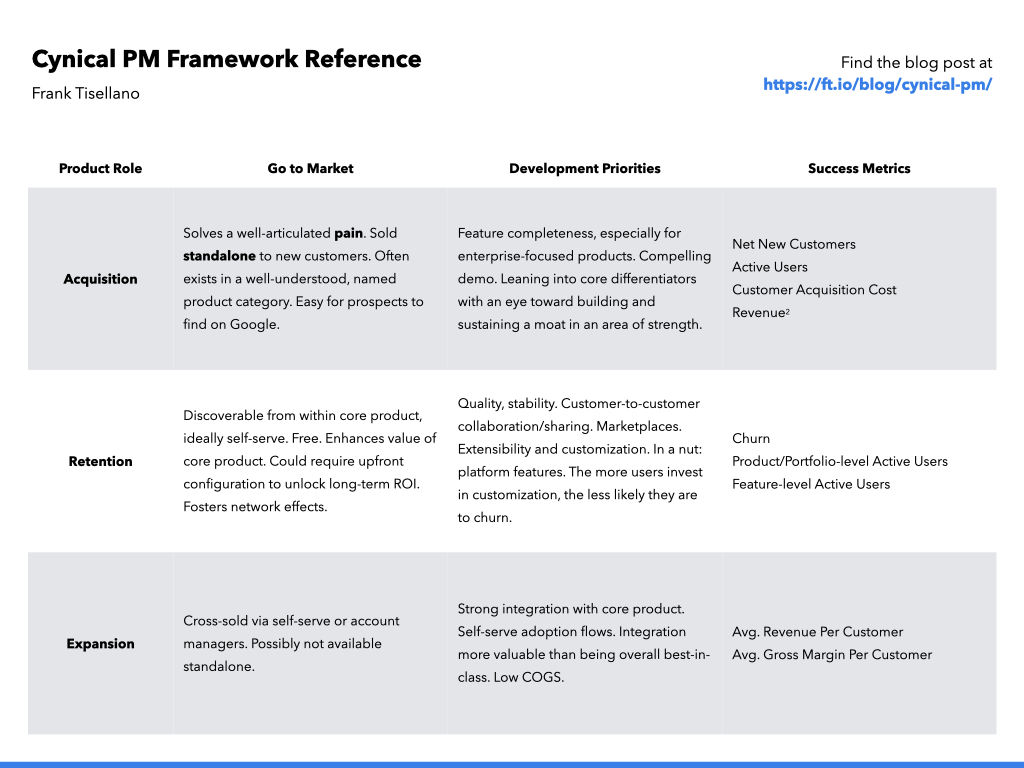The Cynical PM Framework, a business-first approach to product
Of course, as a PM, your first responsibility is to your users. Of course. Focus on the user and all else will follow. Of course.
But. Let’s imagine for just a second that your first responsibility is actually to your business. Let’s put on our Mr. Monopoly hats and monocles and start twisting our mustaches in a manner most devilish. Let’s get cynical.
Every product, every feature even, serves a function in your business. It has one of three jobs:
- Acquire new users or customers
- Retain those users or customers
- Expand engagement or revenue per user or customer
A really important part of your role as a Product Manager is to align stakeholders in your business around which job your product or feature should be doing at a point in time1. In other words: how does your product fit into the portfolio strategically? How does it enable your company to achieve its goals?
When you don’t have clarity about your product’s role in your business, it can be really difficult to have productive conversations about positioning, development prioritization, even how to measure success.
Positioning
Positioning is defining, in your customers’ and potential customers’ minds, where your product stands in relation to other products in your market. Compare how Datadog, arguably the top cloud monitoring company, positions their product relative to Google Cloud’s native monitoring.

Datadog: totally flexible and seemingly all-powerful. Any any any. Databases, servers, storage, Azure, AWS, whatever. You’re running it, they’re monitoring it. Datadog’s positioning (plus sales and marketing) needs to overcome the friction of “we already get monitoring from our cloud provider for almost nothing,” a necessary wall to climb to drive acquisition.
Google Cloud Monitoring: integrated, in context. In in in. Google positions cloud monitoring as almost more feature than product. It’s all about making it as easy as possible to turn on, driving expansion; and to build into a customer’s dependency chain, driving retention.
Prioritization
Imagine you’re the PM for the then-brand-new iCloud Drive. One of the incumbents in your space is Dropbox. Upon launch, do you seek to match their every feature? Do you add fine-grained access controls?
No and no. iCloud Drive is an expansion feature (with a side of retention). You prioritize features that make it as easy as possible for the majority of your users to get their files in. Deliver deep OS integration, including default-on home folder syncing. Friction? Zero. Launch price? Free — up to 5GB, and then once customers love the experience, you make it super easy for them to pay you for more storage, adding another fifty to one hundred very high-margin dollars per customer.
Measuring Success
Critical to stakeholder alignment is alignment around how to measure the success of your product. Which metrics should you use? The definition of success varies tremendously across businesses, so the metrics you use ought to vary as well. Let’s return to our friends at Apple for an example. Imagine Apple’s top-level goals are to continue their revenue growth and to deliver very strong margins.
iPhone, Apple’s best-selling product, has accordingly increased in price over the last few years and has always been a high-margin product. You better believe Tim Cook & co watch iPhone shipments with a high degree of scrutiny, keeping margins at the forefront in supply chain and pricing discussions. iPhone is about high-margin revenue acquisition.
iMessage, on the other hand, almost definitely delivers negative margins. Its infrastructure costs are likely in the billions. It’s totally out of alignment with Apple’s top-level goals, right?
Of course not. iMessage is a churn-prevention behemoth – its job is to drive retention. It would hurt Apple to apply the same success metrics to iMessage as they do to iPhone. For iMessage, a more appropriate metric would be a proxy for stickiness – something like # of messages sent per user.
Reference
Looking for a more concise take? Download this pdf summarizing the characteristics of each job. If you’d like to riff on your own product's job, drop me a line or grab time on my calendar.

These are just a few examples. There are just as many exceptions as rules. In less mature markets or new product categories, your product’s first job might be to define a category in order to enable acqusition. Your product or feature might have a primary and secondary job. The Cynical PM Framework is not intended to be a perfect theoretical taxonomy – its goal is no more and no less than to help you think about your products more strategically.
Either way, just between you and me, I might’ve been a little harsh in calling this approach ‘cynical.’ The reality is, products that don’t have sustainable business models will ultimately fail to survive no matter how much their users love them, and as a result, they’ll fail their users.
PMs need to focus on our user and our business, maximizing the intersection of what serves each. So, focus on your user – by focusing on your business – and all else will follow. Of course.
Of course, business goals change over time. Your product’s job in Year 5 might be different from the job it had in Year 0.↩